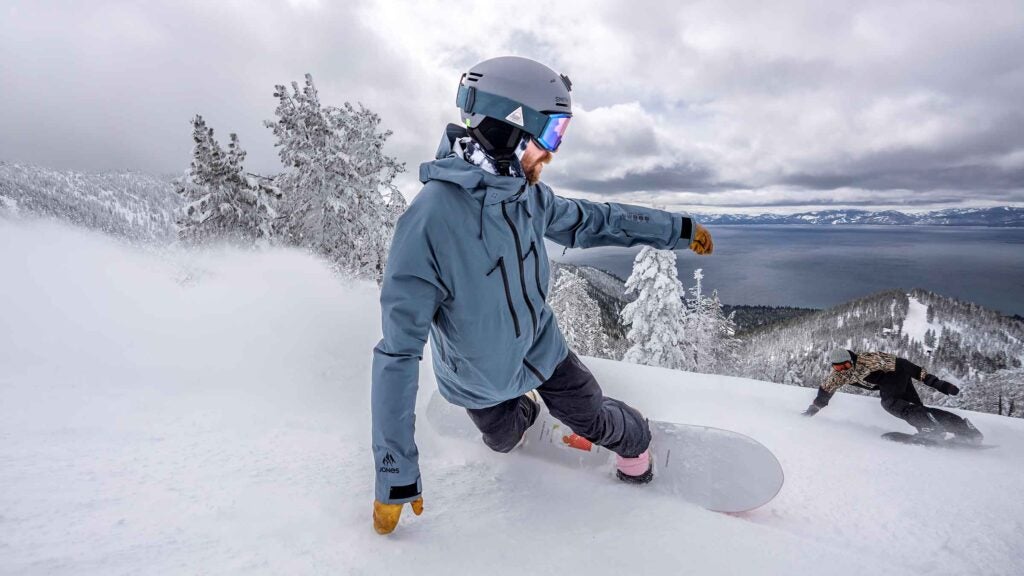No products in the cart.
Outdoor Adventure
The Best Snowboard Bindings of 2025 (26 Tested)
If you’re thinking about your snowboard bindings on the hill, chances are those thoughts aren’t positive. Finicky, unresponsive, uncomfortable, or unreliable bindings are the bane of any rider’s existence—a thorn in your side that, at best, leads to under-your-breath expletives while strapping in. At worst? They’ll send you to the ski patrol shack cradling a dislocated limb or leave you stranded miles deep in the backcountry.
On the other hand, high-quality, functional, trustworthy snowboard bindings, like the ones you’ll find below, don’t spawn temper tantrums or avoidable crashes. You won’t think about them for a millisecond. Instead, they’ll facilitate flow-state ripping—relaying predictable commands from your boots to board. If your current snowboard bindings are ready for retirement—or, perhaps, Facebook Marketplace—you can’t go wrong with the options below.
Check out all our picks for the best snowboards of 2025.
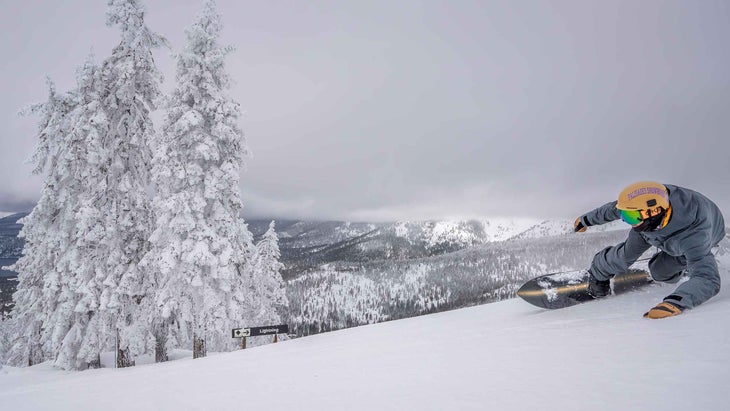
At A Glance
If you buy through our links, we may earn an affiliate commission. This supports our mission to get more people active and outside. Learn more.

Editor’s Choice
Union Atlas
$370 at Evo $370 at Blauer Boardshop
Size Range: S, M, L
Pros and Cons
⊕ Excellent all-mountain and freeride performance
⊕ Reliability at high-speed
⊕ Durable
⊕ Decent dampening
⊕ Easier forward lean adjuster
⊕ More approachable highback for the masses
⊗ Not the most shock-absorbing binding
⊗ Softer highback than previous model
If you would rather blast through chop than daintily pick your way through it, Union’s updated Atlas binding is an all-mountain workhorse that can handle everything from hellish straightlines to heavy cliff drops. Thanks largely to a stiff, carbon-injected nylon baseplate and highback, it’s a lively, responsive binding that likes to go big and go fast. “You can put the pedal down at a moment’s notice,” reported John Lauer, a longtime tester, bootfitter, and snowboard buyer for local shop Tahoe SportsHub who’s primarily ridden the Atlas over the last couple of seasons.
For dampening, Union deploys high-density, vibration-reducing Vaporlite bushings between the board and baseplate. I found the bushings, which are made of a lacrosse ball-type rubber, to be firm. They might not absorb bigger impacts as well as a softer rubber or foam, but they provide moderate dampening and, more important for charging riders, immediate response.
The Atlas’ removable disc cover—referred to as “gas pedals” by the Italian binding maker’s marketing department—features a mix of firm, non-stick EVA foam and hard plastic, a combo that results in excellent energy transfer and decent dampening. There is an extra insert of softer foam that sits beneath the toe of the gas pedal, which testers reported offers welcome suspension on chundery traverses and flat landings.
Atlas aficionados will recognize that the highback is newly designed, with a slanted slot down the gut. The redesigned highback still offers edge-to-edge stiffness, but it’s noticeably more pliable laterally, making the new Atlas increasingly suited for all-mountain freestyle applications and more approachable for intermediate riders. A more aggressive tester and longtime Atlas lover was disheartened by the change, however. “It was perfect [the way it was.] It’s a little softer now, but that does make it better suited for the masses,” he lamented.
Other updates include an improved forward lean adjuster (the higher the angle of a binding’s highback, the more aggressive the stance), as Union nixed last year’s more streamlined but icing-prone integrated wheel for a bulkier, more standard, reliable pull-tab mechanism. Some advanced riders never touch forward lean, while others may tweak it based on the conditions or terrain at hand. For those folks, having a reliable, easy-to-use forward lean adjuster is subsequently valuable. “The highback is easily adjustable on the hill,” commented one such expert, snowboard instructor Nico Henss, who was appreciative of the new pull-tab style adjustor. “You tilt the highback a few degrees and it impacts the edge pressure insanely well.”
Henss also loved the updated straps, judging them highly responsive and comfortable without unnecessary bulk or bells and whistles. “They fit perfectly, [have] no pressure points, and are easy to adjust in any direction,” he said. One complaint? The toe strap can shift positions while unstrapped. Union designed the toe strap housing in the base plate for easy adjustments, allowing it to pop into a forward or back position based on rider boot size and preference, but the toe strap, unfortunately, doesn’t lock in place.
That didn’t detract from his love for the Atlas, though. “It fits so many riding styles and terrain—super versatile,” Henss gushed.
If you’re looking for an even more responsive option with similar specs, check out the Atlas Pro.
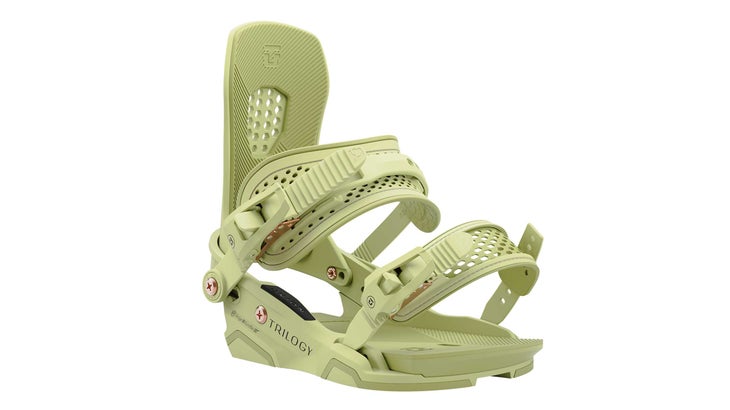
Best Women’s Binding
Union Trilogy
$330 at Evo $330 at Blauer Boardshop
Size Range: S, M, L
Pros and Cons
⊕ Excellent all-mountain performance
⊕ Extremely comfortable
⊕ Easily adjustable
⊗ Middle-of-the-road stiffness and flex
If this binding is good enough for the G.O.A.T., it’s good enough for you. Ridden by legend Jamie Anderson and hordes of savvy snowboarders around the world, Union’s best-selling Trilogy was our favorite women’s binding in test. It continues to be the go-to pick for all-mountain riders wanting a balance of high comfort and high performance.
“Any rider looking for a bread and butter binding for everyday riding should look no further than the Trilogy,” opined longtime snowboard instructor, discerning test veteran, and hard-charging Tahoe rider Anna Doucette. After testing the Trilogy while carving groomers, navigating tight trees, jumping off windlips, and sending steeps, Douccette appreciated the balance of cushioning and response thanks to the padded straps. “The straps are very ergonomic, and, like a good hug, hold the feet snugly,” she reported.
Comfort and dampening, testers reported, also stem from ergonomic canting and EVA padding, the latter of which graces the baseplate and highback. “Thanks to the foam baseplate padding, the Trilogy has a cush-yet-solid feel underfoot,” commented Doucette. Another Tahoe tester also appreciated the middle-of-the-park flex, calling it, “not too soft, not too stiff,” although she did crave more backbone during full-throttle freeride runs.
A Mammoth tester, Gela Malek Pour, chimed in, appreciating the Trilogy’s customizability, which includes slideable toe and ankle straps that can be easily adjusted without tools in the liftline. “These bindings offer a ton of adjustability options to create the perfect fit,” she raved. “The toe strap molds perfectly to any toecap shape, and the adjustable toe ramp placement makes finding the right fit even easier.”
Lastly, Doucette reported that she loved the extruded, 3D aluminum heel cup, calling it “indicative of the overall binding construction—solid.”
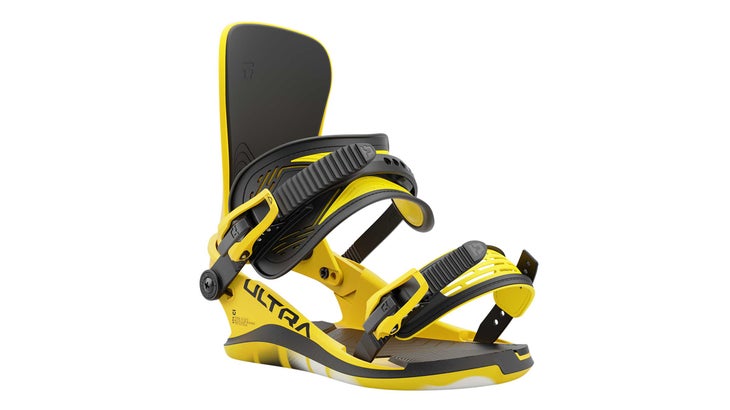
Best Freestyle-Ready Flex
Union Ultra
$300 at Evo (Men’s) $300 at Evo (Women’s)
Size Range: S, M, L (men’s) S, M, L (women’s)
Pros and Cons
⊕ Super damp ride
⊕ No unnecessary bells and whistles
⊕ Freestyle-friendly flex
⊕ Top-tier torsional tweakability
⊗ No forward lean adjustor
Available in both men’s and women’s versions and built to comfortably crush freestyle features, Union’s Ultra is a smart pick for park riders and jibby all-mountain freestylers. The binding is exceptionally pliable and pressable for creative freestyle riding thanks to an overall mid-soft flex and asymmetrical, bare-bones baseplate that adds significant torsional range of motion. “The tweakability makes it a great binding for freestyle,” said snowboard instructor Nico Henss, who can be found lapping the park when he’s not giving lessons.
Park-ready, tester-approved dampening comes courtesy of a lightweight EVA bushing that cushions your boots, and a vibration-canceling, thermoplastic elastomer outsole that sits on the board. “The high-quality materials give you a safe feeling even when you’re hitting the pro jump line, and the broad baseplate and padding help cushion compressions when you land,” reported Henss. Sierra shredder and test veteran Chris Cloyd agreed: “The foot feel is classic Union—excellent. Durable, plush, no pinch points.”
While testers appreciated the simple design and clean, comfy, and smooth straps and ratchets, multiple riders lamented a lack of forward lean adjustment. If you don’t vibe with the six degrees of fixed forward lean in the Ultra’s Duraflex highback, these are definitely not for you. “They’re arguably the most tweakable bindings in the air, but they’re not the most tweakable bindings on the tuning bench,” joked one rider.
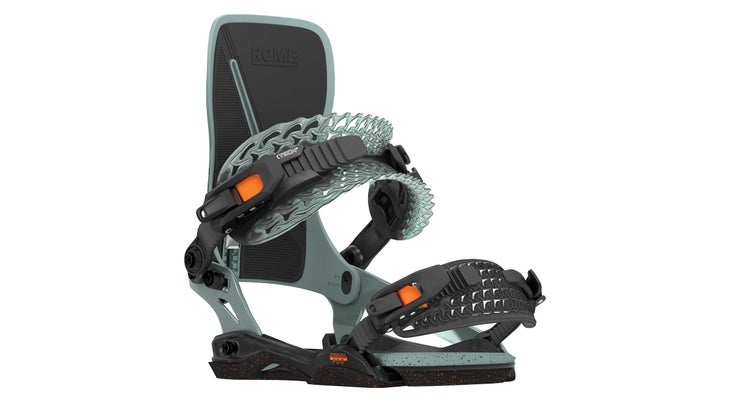
Best Big Mountain Binding
Rome Katana Pro
$450 at Blauer Boardshop $450 at Rome
Size Range: M/L, L/XL
Pros and Cons
⊕ Incredibly customizable
⊕ Stiffer, more responsive flex than the standard Katana
⊕ Great dampening
⊗ Durability concerns around AuxTech binding straps
⊗ Pricey
⊗ Only available in two sizes
Still glowing orange and red from the forge, the Rome Katana Pro is brand new this season. It’s the same Editor’s Choice-winning Katana our testers know and love from last year, just smithed from lighter, stiffer materials.
Much of the componentry is identical to the standard Katana. Both bindings sport the same boot-clutching, shock-absorbing, stretchy AuxTech straps, a tweakable-yet-stable asymmetrical aluminum chassis, a mind-bogglingly adjustable PivotMount ankle strap positioning system, and a cold-resistant, expanded thermoplastic polyurethane foam cushioning our testers dubbed best-in-class dampening.
So—why go Pro and spend the extra 50 dollars? Rome swapped out traditional fiberglass for carbon in the baseplate and highback, resulting in more weight savings, power, and responsiveness. The resulting ride is a “notch or two stiffer than the standard version,” according to an all-mountain Katana collector. That said, Rome smartly added a diagonal slit to the thin-yet-steely highback, which adds a smidgeon of torsional flex.
“If you’re an expert all-mountain rider or freerider who wants the same customizability of the Katana in a more aggressive, responsive package, the Pro is the way to go,” reported our Katana correspondent. His personal plan? Keep the standard Katana mounted on his all-mountain freestyle daily driver, and slap a Pro on his big-mountain freeride gun.
It is worth noting that a long-term test of the standard Katana resulted in a torn Aux Tech ankle strap. While we didn’t have any issues with this year’s Katana Pro, concerns did carry over as the strap tech mirrors the original Katana.
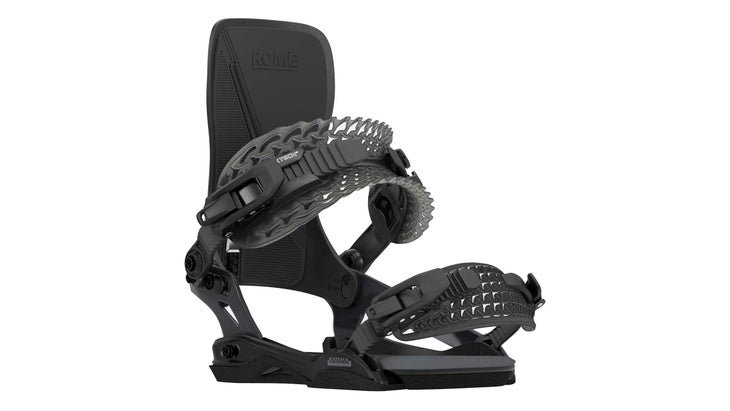
Best Customizability
Rome Katana
$400 at Blauer Boardshop $400 at Rome
Size Range: S, M/L, L/XL
Pros and Cons
⊕ Incredibly customizable
⊕ Best-in-class dampening
⊕ All-mountain, freestyle-meets-freeride flex
⊗ Durability concerns around AuxTech binding straps
If you like to tweak your bindings as much as you tweak your grabs, peep the Rome Katana. This high-performance binding is ultra-adjustable thanks to Rome’s PivotMounts—modifiable ankle strap mounting hardware that enables riders to swap between eight ankle strap positions per side, yielding a total of 64 possible configurations. Raising the ankle strap provides more rapid-fire responsiveness, while lowering the strap position translates to increased range of motion and a surfier ride. Additional adjustability comes courtesy of composite highbacks that pivot and cant for a more ergonomic, fine-tuned fit.
Personally, I’ve found that experimenting with different strap and highback configurations will enable you to find what works best for your riding style. And if you’re swapping one pair of bindings between multiple boards in your quiver, or you like to cruise one day and bomb everything in sight the next, the Katana allows you to make the most of your setup.
Adjustability wasn’t the only reason the Katana sliced through the competition. All-mountain riders appreciated its versatility—it proved responsive in technical lines yet playful in the air thanks to the mid-flexing highback and asymmetrical chassis. The board’s cold-resistant, closed-cell foam padding beneath the baseplate also offers unreal shock absorption.“Great dampening,” reported snowboard guide Andrew Alissandratos. “I took them to Mach 10 and had no chatter.” Additionally, testers loved the geometric-patterned toe and ankle straps, which expand as you tighten the binding, providing a fit one Katana convert called “damn-near vacuum-sealed.”
One ding we should mention: after a heavy spring of testing last year, one tester did rip through the patterned ankle strap early this winter, causing some durability concerns.
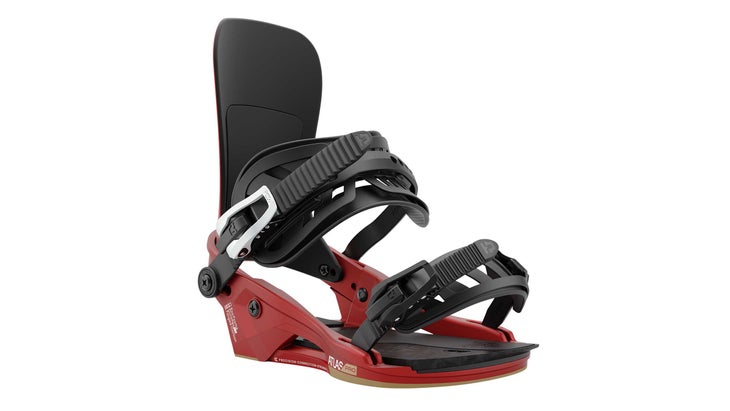
Best Bombproof Binding
Union Atlas Pro
Size Range: S, M, L
Pros and Cons
⊕ Ultra responsive
⊕ Speed demon
⊕ Forged carbon base plates
⊗ Forward lean adjustor can ice over
⊗ Not super damp
⊗ Expensive
The versatile, bombproof, all-mountain Union Atlas has been one of our all-time favorite bindings for years (hence the Editor’s Choice award this year), so when Union debuted the Atlas Pro in 2023, our testers were damn near salivating. This drool-worthy build sports the same carbon-injected nylon baseplate, Vaporlite bushings, and hard-wearing extruded aluminum heelcup as the OG Atlas. However, the Atlas Pro is more responsive thanks to an ultra-reactive, forged carbon footbed and a slightly stiffer, more aggressive highback.
This year, Atlas revamped the Pro with updated straps, including a responsive Hybrid 2.0 ankle strap and two-layer boot-hugging toe strap. “The straps were very comfortable and locked you in well,” reported snowboard guide and tester Andrew Allisandratos.
Not sure whether to splurge on the Pro or stick with the standard Atlas? You’re not alone. “The Atlas Pro is a bit stiffer and more responsive than the Atlas. Pair it with a big mountain board or beefy all-mountain shape and the carbon gas pedals let you approach light speed,” said a tester who spent much of the last few seasons swapping between the Atlas and Atlas Pro. His recommendation: “Intermediate and up all-mountain riders who appreciate a balance of comfort and performance will prefer the relative dampening of the Atlas, while aggressive freeriders and resort rippers who prioritize instantaneous response will fall in love with the streamlined, elite build of the Atlas Pro.”
A couple of testers voiced preference for the beefier, pull-tab forward lean adjustor of the standard Atlas, compared to the rollable wheel that’s integrated into the highback of the Atlas Pro. “It can ice up or just be tricky to operate in cold conditions with gloves on,” noted one rider.
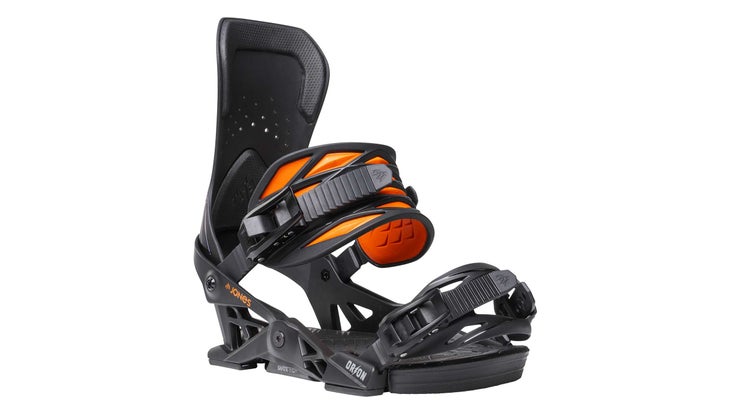
Best All-Mountain Bindings
Jones Men’s Orion and Women’s Aurora Snowboard Bindings
$300 at Evo (Men’s) $300 at Evo (Women’s)
Size Range: M, L (men’s) S, M (women’s)
Pros and Cons
⊕ Reliable progressive-flexing highback
⊕ Intermediate friendly
⊕ Efficient power transfer
⊕ Comfy padding and construction for all-day riding
⊕ Upgraded buckles and toe straps
⊗ Soft for some freeride applications
The Jones Orion (men’s) and Aurora (women’s) surfy, intermediate-friendly all-mountain bindings continue to be a major hit with our test team. They have the same construction, but the Aurora bindings have scaled down sizes and flexes. That said, advanced, cruisy riders will love these, bindings, too. While our testers hardly noticed any changes on the hill, both got minor upgrades for the 2024/2025 season beefier, stronger, faster buckles and minimalistic toestraps.
Both the Aurora’s and the Orion’s highbacks are stiffer at the heel cup and softer towards the calf, offering a great balance between performance and play. “When transitioning from edge to edge, the highback gives you all the support you need,” reported a rider who’s been enjoying the Orion since its debut a few seasons back. When you start playing with other directions—off-axis tweaks, contorted carves, nose or tail presses, et cetera—the softness toward the top of the highback lets you “twist like a yogi,” he said.
Edge-to-edge prowess also comes courtesy of the Canadian binding builder Now Snowboarding’s revolutionary SkateTech, which is at the core of all of Jones’ bindings. The baseplate pivots around the disc housing like a fulcrum, efficiently leveraging rider weight and transferring energy to four bushings at the corners of each binding. Not only does this system yield what our tester called “instantaneous response,” but the rubbery, dampening bushings also “absorb more chatter than the NSA.” Between the bushings and a thick EVA foam footbed, the Orion and Aura are so comfortable they fit the bill for first-to-last-chair riding.
If you like to customize your setup, the bushings can be swapped out for a stiffer or softer ride (stiffer bushings are best for freeriding, and softer bushings are best for more freestyle/surfy riding). What’s more, the flexy-yet-supportive ankle straps are customizable, too: swap the left and right ankle straps to bounce between freeride and surf modes. Freeride-mode locks in the ankle for straight-lining steeps and tackling technical faces, while surf-mode frees up range of motion for slaying side hits and flowy pow days.
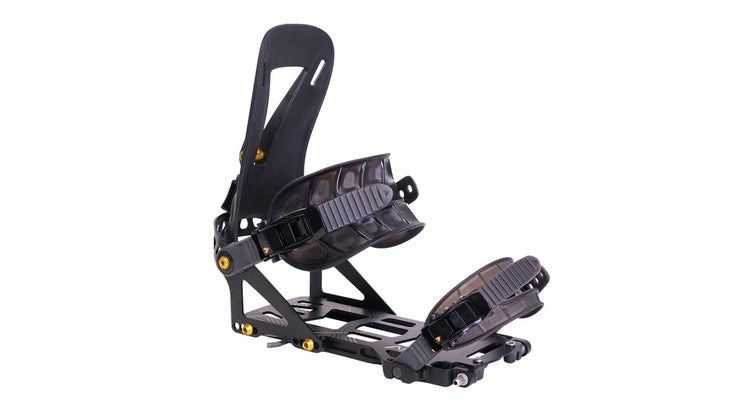
Best Lightweight Split Binding
Spark R&D Arc ST Pro
Size Range: XS-L
Weight: 1.25 lbs per binding (M)
Pros and Cons
⊕ Utilizes Spark’s lowest-weight, highest-end construction
⊕ Surfy
⊕ Smoother-than-ever uphill action
⊕ Easy to maintain interface
⊗ On the soft side for heavier riders or hard chargers (check out the Arc’s stiffer sibling, the Surge ST, if that sounds like you)
⊗ Durability concerns
⊗ Pricey compared to the standard Arc ST
⊗ No dampening on baseplate (although it’s easy to add aftermarket padding)
We’ve said it before and we’ll say it again—we’re big fans of Spark’s Arc ST splitboard bindings. They’re simple, solid, well-designed, and purpose-built for smooth skin track action and surfy descents, making them our go-to recommendation for the vast majority of splitboarders. $160 more than the baseline model, the ST Pro is a supercharged, lighter-weight rendition tailored to the wants and needs of tech-oriented gear nerds, skintrack slayers regularly putting in 5K-vert days, and anyone who wants to shed weight from their split without sacrificing performance.
Just like the standard Arc ST, the Pro utilizes Spark’s tried-and-true puck system—an interface our testers love for its low weight, few moving parts, easy setup at home, and reliability in the field. It also sports the same asymmetrical highback shape and easy-to-operate walk mode, cutout baseplates, and toe- and ankle-strap design, as well as Spark’s “Smooth Touring” (ST) tech that was introduced to critical acclaim a couple of years ago. Essentially, the engineers at Spark over-molded the bushings of the touring brackets and the metal wire of the Whammy Bar risers with thermoplastic to reduce unwanted friction while touring. After testing the tech for the past couple of years, testers report that the new brackets make for smoother, more painless, squeak-free climbing, while the improved Whammy Bars make engaging the risers easier and faster.
So what makes the Pro pricier and lighter? Mostly materials. The Pro uses a stronger 7075 aluminum for thinner, lighter heel loops, Pebax plastics—a common ingredient in ski boots—for the straps and ladders, lighter, stiffer, injection-molded carbon-infused nylon for the highbacks, and custom aluminum hardware instead of the stainless steel standard. The result shaves weight—a pair of standard Spark Arc STs weighs 2.77 pounds per pair compared to the Pro’s 2.5 pounds per pair—and provides a touch more responsiveness due to the carbon highbacks.
Whether the weight savings are worth it depends on your objectives. If you like to hit jumps and aren’t too concerned with weight on the uphill, go with the original Arc STs: they’re beefier. But if you’re regularly trying to keep up with fit skiers or accomplish bigger objectives, the carbon highbacks and weight savings of the Pro are a source of maximum stoke.
That said, testers have snapped two of the Pro’s aluminum screws over the last two years–once on an international expedition—leading them to appreciate the standard Arc, which have beefier, stainless steel hardware. Also, some heavier and hard-charging riders craved more stiffness and response out of the Arc, preferring Spark’s Surge ST.

Best Beginner Split Binding
Spark R&D Arc ST
$459 at Backcountry $459 at Evo
Size range: XS-L
Weight: 1.4 lbs. per binding (M)
Pros and Cons
⊕ Smoother-than-ever uphill action
⊕ Spark’s tester-favorite interface is easy to setup, adjust, and maintain
⊕ Durable, reliable construction
⊕ Surfy yet dependable downhill performance
⊗ Soft for no-fall-zone riding or heavier splitboarders
⊗ Heavier than Pro version
We’ve been fans of Spark’s Arc for years thanks to its practical interface, surfy all-mountain ride, and touring chops. But according to one tester who put the Arc ST through the paces over the last couple of years, “Spark made a smooth binding smoother.”
ST stands for “smooth touring” and references a slew of significant updates like more robust touring risers and brackets over-molded with cold-resistant, self-lubricating thermoplastic. “The connection from the binding to the new touring brackets yields noticeably less friction,” said our tester. “But I was most stoked on the new touring risers.” Spark took the thin wire risers of years’ past and wrapped them in the same thermoplastic as the brackets, enlarging catch points and expediting engagement. “With the old models, sometimes you’d have to really crank on ‘em, wasting precious seconds on the skin track,” said this tester. “The new design is way easier to operate with a quick flick of the pole.”
Spark also improved downhill performance by adding asymmetry to their highbacks for a more ergonomic, natural stance. Whether you’re an entry-level splitter or an experienced backcountry traveler who has no need for a steely, ultra-stiff split binding, the Arc ST is the way to go. Looking for a stiffer, no-nonsense touring companion? Go with Spark’s Surge ST.
It’s worth noting that as of 2023, Spark nixed its men’s and women’s lines in favor of a unisex, boot-length-based sizing system.
How to Choose Snowboard Bindings
Given the endless options and tech jargon at play, shopping for snowboard bindings can be a harrowing endeavor. However, it gets a little easier when you follow these simple tips.
Buy Your Boots First
Your boot size determines your binding size–not the other way around. Boots also determine what boards you should ride, so don’t jump the gun.
Consider Your Riding Style
Are you a park rat? An indiscriminate all-mountain rider? A pedal-to-the-metal freerider? Snowboard bindings are built and advertised toward specific snowboard riding styles. Once you figure out what kind of rider you are, you can easily narrow your search. And if you’re not sure what kind of rider you are, no worries–stick with all-mountain options, as they’re meant to handle anything and everything terrain-wise.
Consider Your Preferred Flex
Do you like stiff bindings or soft ones? Somewhere in the middle? Usually, brands list flex as a numeric rating, usually out of ten, with 10 being stiff as steel and one being soft as a wet noodle. Anything under a five is considered quite soft—that’ll be best for park riders, beginners and intermediates, or cruisy powderhounds. Five to eight tends to be all-mountain bindings that are meant to handle any terrain you can throw at ‘em. Eight and up are generally more freeride specific–stout, stiff bindings you can trust at high speeds in gnarly terrain.
Now, these numbers are subjective and vary from brand to brand. There’s no governing body doing a universal flex test (although that would be sincerely appreciated). Also, riders will inevitably stray from the stereotypes listed above—a freestyle rider who’s hitting the pipe may want a super stiff binding, while a freerider who has a surfy approach may want a softer flex. But they’re a good place to start.
Demo Religiously
If you’re having a hard time figuring out what bindings to buy, the single best thing you can do is demo. Be on the lookout for demo days and events at your local hill. Swap with shred buddies if they’re game. Branch out, trying bindings from different brands. Experiment with different flexes. The more bindings you ride, the more you’ll be able to pinpoint what works for you.
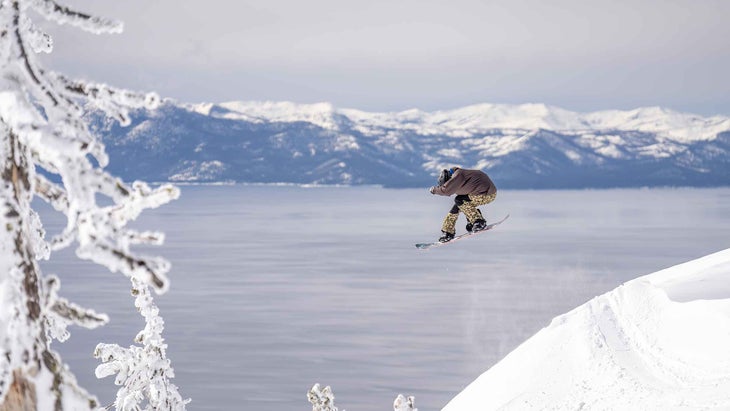
How We Test Snowboard Bindings
- Snowboard Bindings Tested This Year: 26
- Locations Tested: California, Nevada, Utah, Wyoming, Alaska, Japan, Norway, France, Italy, Switzerland
- Highbacks Exploded: 3
- Straps Busted: 2
- Buckles Replaced: 2
- Screws Loose: Too many to count
We start our snowboard binding testing at our annual snowboard test, which took place in 2024 at Tahoe’s Diamond Peak Ski Resort. Conditions were perfect for testing—variable—ranging from windblown powder and pristine corduroy to sunny slush and refrozen mank. A crew of mostly local testers spent several bell-to-bell days testing a variety of boards. However, we encouraged riders to spend more time—a half-day, minimum, up to the full gear test week—testing bindings before filling out detailed review forms. This keeps our snowboard testing more legitimate (we don’t want to change too many variables at once). Plus, it gives riders more opportunity to tweak binding fit and get a feel for bindings across variable conditions.
As we wrap up our Diamond Peak test, we determined what bindings performed the best and should be considered for coverage and awards. We sent those bindings home with testers for long-term testing until the end of the season. When the dust settled, the chairlifts stopped cranking, and splitboarders waved the white flag and rolled out their mountain bikes, we asked those long-term testers to fill out review forms once again.
These review forms ask testers to score bindings quantitatively on categories like overall performance, responsiveness, tweakability, dampening, and durability. Testers also dive deeper on qualitative questions, among them: What terrain or conditions are these bindings best for? How’s the overall build, construction, and durability? How do you like the highbacks? Is the forward lean adjustment easy or a hassle? Finally, I (Drew Zieff, test director), sift through review forms and write the reviews you’ll find below.
Meet Our Testers
Drew Zieff
Zieff is a Tahoe-based freelance writer and a lifelong snowboarder who’s no stranger to breaking bindings. In addition to directing Outside’s snowboard test, a role he’s handled since 2016, he directs Backcountry Magazine’s splitboard coverage and nerds out on snowboard gear and travel for REI, Gear Junkie, and Forbes, among others. He spends his winters testing gear in his backyard backcountry zones or up at Palisades when he’s not chasing stories and storms around the globe.
Chris Cloyd
The only thing more eclectic than Chris Cloyd’s riding style is his resume. A former touring musician, former personal trainer, and still-holding-on endurance athlete who lives in June Lake, CA, Chris Cloyd spends his winters splitboard guiding, teaching AIARE courses, and handling radministrative duties for Blackbird Mountain Guides. In his free time, you can find him crushing couloirs deep in the Eastern Sierras or putting solid boards through their paces at June Mountain. A fan of strong coffee and heavy metal who often combines the two on his way to shred, Cloyd is not remotely gentle on his gear—he lives to thrash.
Jenna Shlachter
Truckee’s own Jenna Shlachter is as brilliant on the hill as she is off it–which is saying something, she’s a Doctor of Psychology, after all. When she’s not on the clock, she’s usually on her snowboard, ripping everything from park to powder. Her trophy shelf needs regular reinforcement, as every year she seems to add banked slalom trophies to her already impressive collection. Lucky for us, Shlachter is also an unabashed snowboard nerd, and she’s been a key contributor to our snowboard test for the last few seasons.
Anna Doucette
Anna Doucette is a lifelong snowboarder who’s been a member of the American Association of Snowboard Instructors for two decades. She’s spent so many years articulating difficult-to-grasp movements to aspiring riders and fellow instructors that she’s a natural and extremely articulate gear reviewer, and she’s been a key contributor to our Tahoe testing.

